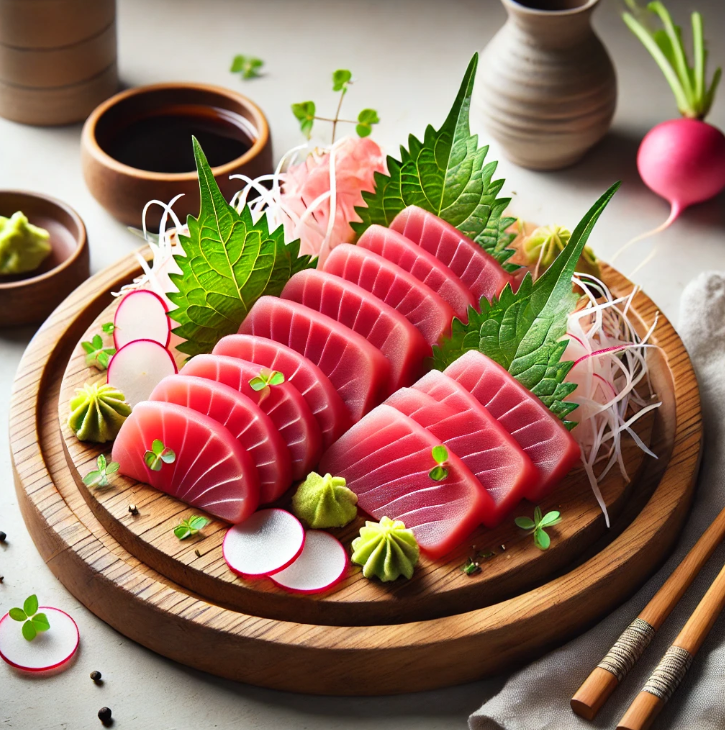Tuna sashimi is more than just a dish—it’s an art form that celebrates the beauty of simplicity and freshness. Originating from Japan, sashimi has become a global phenomenon, captivating food lovers with its delicate flavors and elegant presentation. This guide dives deep into the world of tuna sashimi, exploring its types, preparation techniques, nutritional benefits, and much more. Whether you’re a seasoned foodie or new to sashimi, this article will guide you through every essential detail about this culinary treasure.
Table of Contents
Introduction to Tuna Sashimi
What is Tuna Sashimi?
Tuna sashimi is a Japanese delicacy made from raw slices of tuna served without rice. It’s all about showcasing the natural flavor and texture of the fish, making freshness the most critical factor. Often enjoyed with traditional condiments like soy sauce, wasabi, and pickled ginger, sashimi emphasizes pure, unadulterated taste.
Why is Tuna Sashimi Popular Worldwide?
Over the years, tuna sashimi has captured the hearts of food enthusiasts worldwide. Its clean, rich flavor, combined with its melt-in-your-mouth texture, makes it a standout dish. Plus, it’s versatile—perfect as a light appetizer or the centerpiece of a sophisticated meal. With the rising interest in Japanese cuisine, sashimi has become a symbol of culinary elegance and health-conscious eating.
Brief History and Cultural Importance of Sashimi
The art of sashimi dates back centuries, rooted in Japan’s deep respect for fresh seafood. Traditionally, sashimi was served as a dish for the elite, showcasing a chef’s knife skills and understanding of fish. Today, it’s enjoyed by people across the globe, representing a harmony between tradition and modern culinary practices.
Types of Tuna Used in Sashimi
Bluefin Tuna: The King of Sashimi
When it comes to tuna sashimi, bluefin tuna reigns supreme. Known for its rich, buttery flavor and tender texture, this variety is a favorite among sashimi lovers. Bluefin is prized for its high fat content, especially in the otoro (belly) section, which melts in your mouth with every bite. Its luxurious taste makes it a popular choice in high-end sushi restaurants worldwide.
Yellowfin Tuna: A Lighter Option
Yellowfin tuna, also called ahi tuna, offers a leaner, milder flavor compared to bluefin. It has a slightly firmer texture, making it an excellent option for those who prefer a less fatty sashimi. Yellowfin’s versatility and availability have made it a staple in many sashimi platters.
Bigeye Tuna: A Flavorful Choice
Bigeye tuna is another favorite for sashimi, often sitting between bluefin and yellowfin in terms of flavor and texture. Its higher fat content compared to yellowfin gives it a richer taste, while its deep red color adds a visual appeal to any sashimi presentation.
Albacore Tuna: The Mild and Tender Option
For a lighter and more delicate option, albacore tuna is a fantastic choice. Often referred to as “white tuna,” albacore has a creamy, mild flavor that pairs beautifully with citrus-based sauces or garnishes. It’s ideal for sashimi newcomers looking for a subtle introduction to raw fish.
Each type of tuna brings something unique to the table, making it versatile for every palate.
How to Prepare Tuna Sashimi
Selecting Fresh Tuna: What to Look For
The first step in making exceptional tuna sashimi is selecting the freshest fish. Look for sushi-grade tuna, which ensures the fish is safe to eat raw. Fresh tuna should have a bright, vibrant color—deep red for varieties like bluefin or bigeye. Avoid fish with a dull appearance or strong odor, as this indicates it’s past its prime.
Proper Knife Techniques for Slicing
Perfect sashimi begins with the right tools. A sharp knife designed for slicing fish, such as a yanagiba or sashimi knife, is essential. Before slicing, ensure the tuna is chilled to make cutting easier and more precise. To slice:
- Trim away any sinew or uneven edges.
- Hold the knife at a slight angle and cut the tuna into uniform, thin slices.
- Use smooth, single strokes to avoid tearing the fish.
Proper slicing enhances the texture and presentation of your tuna sashimi.
Serving Suggestions for Presentation
Presentation is key to sashimi. Arrange the tuna slices neatly on a plate and garnish with traditional accompaniments like shiso leaves, daikon radish, or wasabi. A small bowl of soy sauce for dipping completes the dish. You can also add a modern twist by pairing it with microgreens or a drizzle of ponzu sauce.
By carefully selecting, slicing, and serving the tuna, you’ll create a tuna sashimi experience that’s both delicious and visually stunning.
Nutritional Benefits of Tuna Sashimi
Low in Calories, High in Protein
One of the biggest reasons tuna sashimi is a favorite among health-conscious eaters is its nutritional profile. Tuna is naturally low in calories while being packed with lean protein, making it a satisfying option that supports muscle growth and weight management. For every 100 grams, it offers approximately 20–25 grams of protein with just 100–130 calories, depending on the variety.
Rich in Omega-3 Fatty Acids
It is also an excellent source of omega-3 fatty acids, which are essential for brain health, reducing inflammation, and improving heart health. These healthy fats can help lower triglyceride levels, support cognitive function, and even improve mood. Including tuna sashimi in your diet is an easy and delicious way to boost your omega-3 intake.
Packed with Essential Vitamins and Minerals
In addition to protein and healthy fats, tuna is rich in vitamins like B12, which supports energy production and nerve function. It also contains important minerals like selenium, which acts as a powerful antioxidant, and iron, which helps transport oxygen throughout the body.
If you enjoy seafood dishes with simple yet elegant flavors, consider exploring recipes like Maine Lobster Rolls for a coastal twist.
Pairing Tuna Sashimi with Other Foods
Traditional Pairings with Sashimi
Classic accompaniments elevate the flavor of tuna sashimi without overpowering it. A light dip in soy sauce with a dab of wasabi enhances the natural umami of the tuna. Pickled ginger, served as a palate cleanser, allows you to fully appreciate the delicate taste of each bite.
Modern Twists: Fusion Pairings
While traditional flavors are timeless, modern chefs have introduced creative pairings that bring a fresh spin to tuna sashimi. Thinly sliced avocado or a drizzle of tangy ponzu sauce complements the creamy texture of the fish. For a burst of flavor, try pairing sashimi with citrus-based toppings like yuzu or orange zest. These additions not only add a modern flair but also highlight the clean, rich taste of the tuna.
Pairing tuna sashimi with the right sides and sauces ensures a balanced, flavorful dining experience.
Tuna Sashimi vs. Other Forms of Tuna
Sashimi vs. Sushi: What’s the Difference?
While tuna sashimi and sushi are often mentioned together, they’re not the same thing. Sashimi refers solely to thin slices of raw tuna, served without rice or additional ingredients. On the other hand, sushi includes rice seasoned with vinegar, often paired with toppings like tuna, salmon, or vegetables.
For sashimi lovers, the emphasis is on the pure, clean flavor of the tuna. Sushi, however, combines multiple textures and tastes, making it a more complex bite. Both dishes have their charm, but sashimi is ideal for those who want to savor tuna in its most natural form.
Raw vs. Seared Tuna: Which is Better for Sashimi?
Traditional tuna sashimi is served raw to highlight its delicate flavor and buttery texture. However, seared tuna, also called tataki, offers a different experience. In tataki, the tuna is lightly seared on the outside while remaining raw in the center. This adds a smoky, charred flavor while preserving the freshness of the fish.
Both raw and seared tuna have their merits, so it comes down to personal preference. If you’re a fan of bold, smoky notes, tataki might be your go-to. For purists, raw sashimi is the ultimate choice.
If you’re looking for another healthy recipe idea, try this Zucchini Baked Ziti for a nutritious balance.
FAQs About Tuna Sashimi
Is Tuna Sashimi Safe to Eat?
Yes, as long as it’s made with sushi-grade tuna. This label indicates the fish has been carefully handled, frozen to kill parasites, and is safe for raw consumption. Always purchase your tuna from a reputable source to ensure its quality.
How Do You Store Tuna for Sashimi?
To maintain freshness, store sashimi-grade tuna in the coldest part of your fridge and consume it within 24 hours. If you need to keep it longer, freeze it immediately and thaw it slowly in the refrigerator when ready to use.
Can I Use Frozen Tuna for Sashimi?
Absolutely! In fact, freezing tuna is a common practice to preserve its quality and safety. Just make sure the frozen tuna is labeled as sushi- or sashimi-grade before using it raw.
What Are the Best Cuts of Tuna for Sashimi?
The otoro (fatty belly) is the most prized cut of tuna sashimi, offering a rich, melt-in-your-mouth texture. The akami (leaner loin) is another popular choice for its bold, clean flavor.
How Do You Make Sashimi at Home?
Making sashimi at home requires fresh, high-quality fish, a sharp knife, and proper slicing techniques. Always handle the tuna carefully and serve it with traditional garnishes for an authentic experience.
Final Thoughts: Why Tuna Sashimi is a Must-Try
Key Takeaways
Tuna sashimi is a true culinary masterpiece that showcases the pure, unadulterated flavors of fresh tuna. From its buttery texture to its clean, delicate taste, this dish represents the perfect harmony of simplicity and sophistication. Whether you’re new to sashimi or a seasoned sushi lover, tuna sashimi is an experience worth savoring.
Encouragement to Explore
Don’t hesitate to experiment with different cuts, garnishes, and pairings to find your favorite way to enjoy tuna sashimi. With its health benefits and versatile nature, this Japanese delicacy deserves a spot on your next menu. Dive in and let your taste buds celebrate!
For more appetizer ideas, check out this recipe for Smoked Jalapeño Poppers to complement your seafood dish.
FAQs About Tuna Sashimi
Can I Make Tuna Sashimi Without Special Tools?
Yes! While a sashimi knife is ideal for precise cuts, any sharp kitchen knife can work in a pinch. Just be sure to make clean, smooth strokes to preserve the fish’s texture.
What’s the Ideal Thickness for Sashimi?
For tuna sashimi, slices are typically about ¼ inch thick. This thickness balances flavor and texture while ensuring each bite is satisfying.
Can Tuna Sashimi Be Served as a Meal?
Absolutely! Combine tuna sashimi with a light salad, miso soup, or steamed rice for a complete meal that’s both nutritious and delicious.
How Do You Prevent Sashimi from Drying Out?
To keep sashimi fresh, cover it with plastic wrap and chill it until serving. Serve it immediately after preparation to maintain its texture and flavor.
For more inspiration on how to prepare and serve tuna sashimi at home, check out the recipes and tips at Food Network. Their comprehensive guides offer creative ideas and expert advice for mastering sashimi and other Japanese dishes!



2 thoughts on “Tuna Sashimi: A Guide to This Japanese Delicacy”